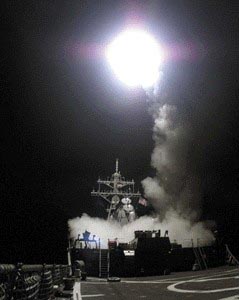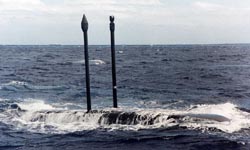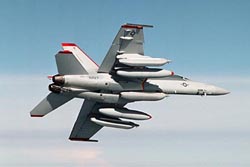Page 1
Daily News
By Gail Helmer
| Send Us News | Archives | Main |
Monday August 26, 2002
PC News
- New Screens: IL-2 Sturmovik v1.2
- Tactical Tomahawk Completes Landmark First Flight
- Advanced SEAL Delivery System Completes Fleet Exercise
- Boeing Completes Flight Demonstrations Of EA-18G
New Screens: IL-2 Sturmovik v1.2
Ubi Soft has sent us 12 new screens from the upcoming IL-2 Sturmovik upgrade version 1.2. The upgrade includes four new flyable aircraft including the Yak-9, Yak-9D, Bf-109-E-7/NZ and Ju-87B-2, and features 10 new single player missions and six new cooperative online missions for the IL-2 community. Version 1.2 will be available for download in three weeks from the official IL-2 Sturmovik website.
Military News
Tactical Tomahawk Completes Landmark First Flight
Raytheon Company and the U.S. Navy successfully completed the first demonstration test flight (DT- 0) of the Raytheon-produced Tactical Tomahawk today at the Naval Air Systems Command sea range near Point Mugu, Calif. This landmark flight test demonstrated new tactical capabilities for the Navy's next generation long- range precision strike weapon.
DT-0 demonstrated all pre-launch and in-flight missile functionality. Launched from a vertical ground launcher, the Tactical Tomahawk successfully met all test objectives that included missile performance from pre-flight initialization through simulated attack; demonstration of all flight modes, terminal maneuvers, variable dive angles and fuzing function; and demonstration of two-way satellite communication, en route mission flex and GPS/Digital Scene Matching Area Correlation (DSMAC) navigation.
Tomahawk, the surface- and submarine-launched, precision strike stand-off weapon, is the Navy's weapon of choice for critical, long-range precision strike missions against high value, heavily defended targets.
Tactical Tomahawk will incorporate innovative technologies to provide new operational capabilities while dramatically reducing acquisition and life cycle costs. Scheduled for fleet introduction in 2004, the Tactical Tomahawk will cost less than half of a newly built Block III missile and will have the capability to respond to changing battlefield conditions through the use of its loiter and mission flex features.
Advanced SEAL Delivery System Completes Fleet Exercise
Northrop Grumman Corporation has completed another important step in delivering the first Advanced SEAL Delivery System (ASDS) to the U.S. Navy by successfully completing its first operational mission as part of the Joint Forces Command's Exercise, Millennium Challenge 2002.
On Aug. 1 and 2, ASDS Boat 1 successfully delivered SEALs and their equipment during nighttime exercises to a precise drop-off point off the coast of Hawaii. Additionally, lock-out operations were completed, enabling the submerged departure of SEALs and their equipment. The last step was submerged recovery of SEALs at mission completion. The ASDS performed exactly as planned and participants praised the achievement.
Since December 2001, Boat 1 has successfully completed an aggressive schedule of testing designed to demonstrate the capabilities of the ASDS and prepare it for an operational evaluation in mid-2003.
Recent testing has included docking and launching maneuvers on a stationary primary host simulator that replicates the mating structures on a host submarine, demonstrating submerged anchoring ability, and conducting diver lock-in/lock-out operations. These tests continue to prepare Boat 1 for dynamic launch and recovery operations from USS Greeneville (SSN-772) in the fall of 2002.
Boeing Completes Flight Demonstrations Of EA-18G
Boeing has completed two more successful flight demonstrations of its EA-18G Airborne Electronic Attack, or AEA, concept aircraft. During the demonstrations on August 20 and 22, an F/A-18F Super Hornet carrying three ALQ-99 jamming pods and two fuel tanks measured noise, vibration, data loads and assessed aircraft flying qualities.
The EA-18G is one of the platforms under consideration to replace the EA-6B Prowler electronic warfare aircraft. The U.S. Navy has an operational need to begin replacing the Prowler by 2008.
"We've completed five flight demonstrations so far," said Paul Summers, Boeing EA-18G program manager. "With each flight we've systematically expanded the carriage envelope with the ALQ-99 jamming pods. Our flight program has taken us to 30,000 feet and 0.9 times the speed of sound, further validating our concept and our capability to perform the airborne electronic attack mission."
The first two flight demonstrations took place in late 2001, with the third taking place in early 2002. Northrop Grumman, Boeing's teammate, instrumented the ALQ-99 jamming pods to gather the noise and vibration information.
Boeing began exploring the possibility of modifying the F/A-18F for the AEA mission in 1993. Since then, Boeing has performed detailed design activities, conducted full-scale antenna range testing and wind-tunnel tests. The U.S. Navy recently completed initial full-spectrum electromagnetic compatibility testing of an F/A-18 Super Hornet with radiating ALQ-99 pods. In addition, more than 450 Navy and Marine Corps aircrew have been through the manned cockpit simulator in St. Louis. Aircrew feedback has been used to refine the EA-18G crew vehicle interface concept.
The EA-18G will perform full-spectrum electronic surveillance and attack of enemy threat radars and communications nets. A derivative of the two- seat F/A-18F Super Hornet - a platform which is in production today - the EA-18G leverages the U.S. Navy's investment in the F/A-18E/F Super Hornet platform and Northrop Grumman's Improved Capability III electronic attack system, which significantly reduces risk over unproven platforms and systems. The EA-18G is more than 90 percent common with the Super Hornet and is expected to significantly reduce support and training costs for the U.S. Navy.
The combination of a validated design, proven platform and proven electronics positions the EA-18G program to begin a System Development and Demonstration phase in 2004, with aircraft in the fleet as early as 2009.
| Send Us News | Archives | Main |


